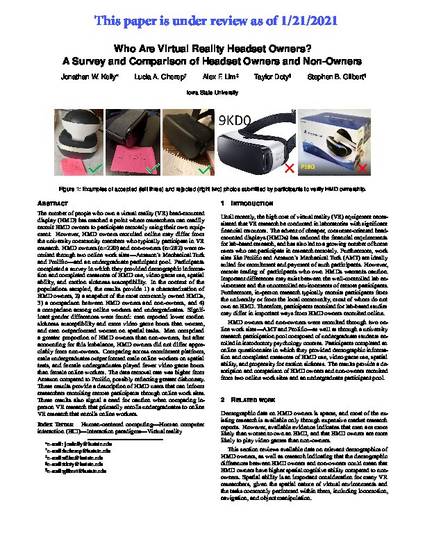
The number of people who own a virtual reality (VR) head-mounted display (HMD) has reached a point where researchers can readily recruit HMD owners to participate remotely using their own equipment. However, HMD owners recruited online may differ from the university community members who typically participate in VR research. HMD owners (n=220) and non-owners (n=282) were recruited through two online work sites-Amazon's Mechanical Turk and Prolific-and an undergraduate participant pool. Participants completed a survey in which they provided demographic information and completed measures of HMD use, video game use, spatial ability, and motion sickness susceptibility. In the context of the populations sampled, the results provide 1) a characterization of HMD owners, 2) a snapshot of the most commonly owned HMDs, 3) a comparison between HMD owners and non-owners, and 4) a comparison among online workers and undergraduates. Significant gender differences were found: men reported lower motion sickness susceptibility and more video game hours than women, and men outperformed women on spatial tasks. Men comprised a greater proportion of HMD owners than non-owners, but after accounting for this imbalance, HMD owners did not differ appreciably from non-owners. Comparing across recruitment platform, male undergraduates outperformed male online workers on spatial tests, and female undergraduates played fewer video game hours than female online workers. The data removal rate was higher from Amazon compared to Prolific, possibly reflecting greater dishonesty. These results provide a description of HMD users that can inform researchers recruiting remote participants through online work sites. These results also signal a need for caution when comparing in-person VR research that primarily enrolls undergraduates to online VR research that enrolls online workers.
Available at: http://works.bepress.com/jonathan_kelly/51/

This article is published as Kelly, Jonathan W., Lucia A. Cherep, Alex F. Lim, Taylor Doty, and Stephen B. Gilbert. "Who Are Virtual Reality Headset Owners? A Survey and Comparison of Headset Owners and Non-Owners." In 2021 IEEE Virtual Reality and 3D User Interfaces (VR), pp. 687-694. IEEE, 2021. DOI: 10.1109/VR50410.2021.00095. Posted with permission.